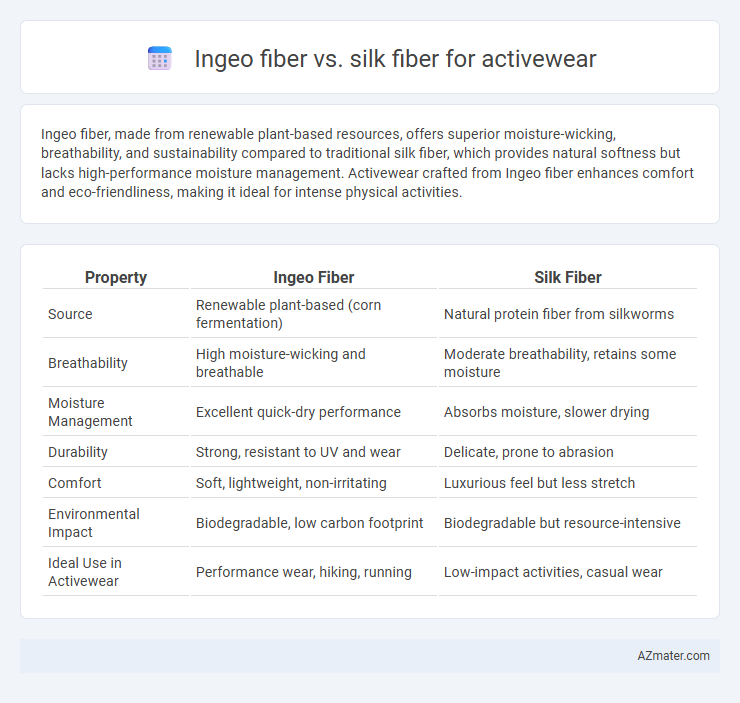Ingeo fiber, made from renewable plant-based resources, offers superior moisture-wicking, breathability, and sustainability compared to traditional silk fiber, which provides natural softness but lacks high-performance moisture management. Activewear crafted from Ingeo fiber enhances comfort and eco-friendliness, making it ideal for intense physical activities.
Table of Comparison
| Property | Ingeo Fiber | Silk Fiber |
|---|---|---|
| Source | Renewable plant-based (corn fermentation) | Natural protein fiber from silkworms |
| Breathability | High moisture-wicking and breathable | Moderate breathability, retains some moisture |
| Moisture Management | Excellent quick-dry performance | Absorbs moisture, slower drying |
| Durability | Strong, resistant to UV and wear | Delicate, prone to abrasion |
| Comfort | Soft, lightweight, non-irritating | Luxurious feel but less stretch |
| Environmental Impact | Biodegradable, low carbon footprint | Biodegradable but resource-intensive |
| Ideal Use in Activewear | Performance wear, hiking, running | Low-impact activities, casual wear |
Introduction to Ingeo and Silk Fibers in Activewear
Ingeo fiber, made from renewable plant-based materials like corn, offers moisture-wicking, breathability, and biodegradability, ideal for eco-conscious activewear. Silk fiber, derived from silkworms, provides natural temperature regulation, softness, and durability, enhancing comfort in performance clothing. Both fibers contribute distinct benefits to activewear, balancing sustainability with functionality.
Fiber Origin: Plant-Based Ingeo vs. Natural Silk
Ingeo fiber is derived from renewable plant-based sources such as corn starch, making it a sustainable alternative for activewear production. Silk fiber, produced by silkworms, is a natural protein-based fiber known for its luxurious texture but relies on animal-derived origins. The plant-based origin of Ingeo offers biodegradability and reduced environmental impact compared to the animal-dependent cultivation of silk.
Performance: Moisture Wicking and Breathability
Ingeo fiber offers superior moisture-wicking capabilities compared to silk fiber, efficiently drawing sweat away from the body to keep activewear dry during intense workouts. Its natural breathability enhances airflow, preventing overheating and ensuring comfort throughout physical activity. While silk provides a smooth feel, Ingeo's advanced fiber structure optimizes moisture management and ventilation, making it a preferred choice for high-performance activewear.
Comfort and Skin Sensation
Ingeo fiber offers superior moisture-wicking properties and breathability, providing a soft, lightweight feel ideal for activewear that keeps skin dry and comfortable during intense workouts. Silk fiber delivers a naturally smooth texture and excellent thermal regulation, enhancing skin sensation with its luxurious softness and hypoallergenic qualities. While Ingeo excels in stretch and durability for high-performance activities, silk provides unmatched comfort and gentle touch, making both fibers valuable for different activewear preferences.
Durability and Longevity
Ingeo fiber, derived from renewable plant sources, offers higher durability and resistance to wear compared to traditional silk fiber, making it ideal for activewear subjected to frequent washing and intense movement. Ingeo's natural moisture-wicking and UV resistance enhance the longevity of garments by maintaining fiber integrity over time. Silk, while luxurious and smooth, tends to be more delicate and prone to abrasion, resulting in shorter lifespan under activewear conditions.
Sustainability and Environmental Impact
Ingeo fiber, derived from renewable plant-based sources like corn, offers a biodegradable and low-carbon alternative to traditional silk fiber, which involves intensive animal farming and higher water usage. The production of Ingeo fiber consumes less energy and emits fewer greenhouse gases compared to silk, making it a more sustainable choice for activewear. While silk provides natural breathability and moisture-wicking properties, Ingeo's eco-friendly lifecycle significantly reduces environmental impact without compromising performance.
Allergenicity and Skin Sensitivity
Ingeo fiber, derived from renewable plant-based sources, offers hypoallergenic properties making it ideal for activewear in sensitive skin conditions. Silk fiber, while naturally soft and breathable, can sometimes cause allergic reactions due to its protein composition. Ingeo's moisture-wicking and antimicrobial features further reduce skin irritation compared to silk, promoting comfort during intense physical activities.
Care and Maintenance Requirements
Ingeo fiber requires gentle washing in cold water with mild detergent to maintain its moisture-wicking properties and biodegradability, avoiding bleach and fabric softeners that can damage the fiber. Silk fiber demands delicate hand washing or dry cleaning due to its protein-based structure, with cool water and pH-neutral detergents to preserve its natural luster and strength. Both materials benefit from air drying to prevent heat damage, but Ingeo fiber offers easier care with more durability in activewear laundering conditions.
Cost Comparison: Ingeo vs. Silk
Ingeo fiber offers a cost-effective alternative to silk fiber in activewear production due to its renewable plant-based materials and lower manufacturing expenses. Silk fiber entails higher costs linked to labor-intensive harvesting and processing methods, resulting in premium pricing. Brands seeking sustainable yet affordable activewear solutions often prefer Ingeo fiber for balancing performance with economic efficiency.
Best Use Cases and Recommendations for Activewear
Ingeo fiber, derived from renewable plant-based materials, offers moisture-wicking, breathable, and biodegradable properties ideal for sustainable activewear focused on environmental impact and comfort during moderate activities. Silk fiber provides exceptional softness, natural temperature regulation, and antibacterially benefits, making it suitable for low-impact or luxury activewear where skin sensitivity and aesthetics are priorities. For high-performance workouts, blends of Ingeo with synthetic fibers enhance durability and stretch, while silk is best reserved for yoga or leisure wear that emphasizes natural feel and elegance.

Infographic: Ingeo fiber vs Silk fiber for Activewear
 azmater.com
azmater.com